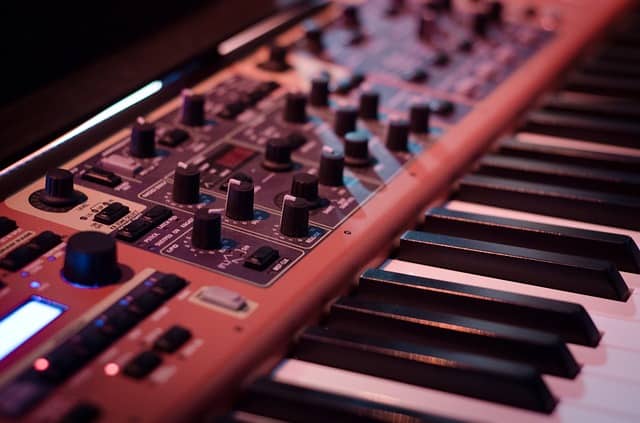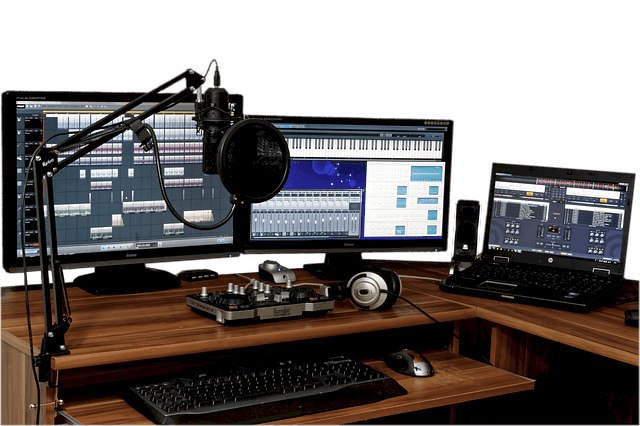There are many powerful and good sounding synthesizers available that are capable of creating a full sound for a song element by itself. Yet, many people can still choose to use multiple synthesizers for the sound design of a single song element, such as a melody or a bassline.
Why use multiple synthesizers for sound design? By using multiple synthesizers, we can combine the different sound qualities of these into one sound. However, there are probably many more possible reasons why we can use multiple synthesizers for sound design.
After this introduction, this post goes more in-depth about some reasons why someone would use multiple synthesizers for sound design.
Using Sounds from Multiple Synthesizers
Almost every useful synthesizer has a unique sound. Even when we use two similar synthesizers with the same settings, then they sound similar, but it is very rarely the same. However, the differences between similar sounding synthesizers can differ from easy hearable to extremely minimal hearable.
For example, when we use two similar synthesizers with only a saw wave active. Then we might hear an obvious difference between these synthesizers, but that does not have to be the case.
A unique synthesizer sound comes at least in two forms. The first form is that a synthesizer can have a setting or combination of settings by which it can make a unique sound. The second form is that a synthesizer can make a certain sound better (opinion-based) than a different synthesizer.
A synthesizer can have more than one unique sound and can be in at least both forms. However, don’t blindly trust the advertisement of a synthesizer with the amount/type of unique sounds they can make.
By combining unique sounds of synthesizers, we can design far more interesting/creative sounds, than by only using one synthesizer. A simple example, we can use a specific synthesizer because it is the only synthesizer we have with a band-pass filter. Also, we can use a different synthesizer because it has the best sounding square wave from all the synthesizers we have.
Similar Synthesizers Do Sound Different
Many people think that there is some synthesizer (like their favorite one) that can make a specific sound precisely like some other synthesizer. Those people can think that for various reasons, and a common reason is that the advertisement of that synthesizer says so. However, almost always, a synthesizer can’t make precisely the sound of a different synthesizer.
The Analog Sound
Almost all (or all) good sounding synthesizers are analog synthesizers or try to emulate the sound of an analog synthesizer. There are many reasons that we like analog sounds, and all of those reasons are opinion-based.
Probably the most common reason that most people like analog sounds is that they sound a bit organic and not perfect. Most people don’t like perfect sounds since people are not perfect themselves, and therefore imperfect feel more natural. Also, most of us see perfect sounds as boring and find that organic sounds are interesting.
As far as I know, there are three cases of synthesizers with an analog sound:
- An analog synthesizer, which can produce (of course) an analog sound.
- A digital synthesizer, which is programmed so that it emulates an analog sound.
- The synthesizer is a combination between an analog and a digital synthesizer. This synthesizer can produce an analog sound, and this analog sound is stronger with a digital modification.
An emulation of an analog sound is never 100% the same as the real analog sound. An emulation always sounds precisely in the way it is programmed.
Analog synthesizers also sound in the way people made it, but their sound can differ a bit during some circumstances. For example, it is possible that when an analog synthesizer becomes older/more used that it starts to sound different, which can be very charming. Also, the hardware of an analog synthesizer can change (like shrinking) a bit when the place where it is in becomes warmer or colder.
Possibility of the Same Sound by Another Synthesizer
Advertisers want us sometimes to believe that their synthesizer can make the same sound as some other synthesizer. However, this belief is probably not true. It may be not true since the creator(s) of a synthesizer most of the time don’t know how others a synthesizer have made that they don’t have made themselves.
Extreme small differences between synthesizers can result in sound differences between them. These sound differences can be very small or easily noticeable.
There is an endless amount of possible differences between synthesizers. Probably, the most common differences are the differences in hardware and algorithms. In this case, algorithms are digital calculations that influence the sound.
To understand the hardware differences, we have to investigate most hardware parts of a synthesizer. To understand differences in algorithms, we have to investigate the programming code of a synthesizer. This code is not publicly available, most of the time.
There are some cases where different synthesizers do sound the same. For example, a company has a version one and two of a synthesizer, and version two has only more options so that it can sound the same as version one.
Another similar example would be that a company took over some other company. After the takeover, they rename/make another version of the synthesizer from the company that they took over.

Different Types of Sound Synthesis
A type of sound synthesis is a method of how a synthesizer generates audio. Two well-known types of sound synthesis are Subtractive and Frequency modulation (FM).
Some types of sound synthesis can make a certain sound that different types of sound synthesis can’t make. Also, some types of sound synthesis can make a certain sound easier than different types of sound synthesis.
For example, FM synthesis can make more sounds and more complex sounds than subtractive synthesis, at least in most cases. Further, subtractive synthesis can make easier the sound of a saw wave than FM synthesis.
In many cases, making a saw wave in subtractive synthesis is possible by selecting a saw wave for an oscillator. However, to make saw wave in FM synthesis, we have to combine multiple sine oscillators correctly, which is commonly.
Learning a specific synthesizer of a specific type of sound synthesis work costs time, and it costs even more time if a synthesizer is complex. To learn how to use how a specific synthesizer also costs time. Therefore, using multiple synthesizers with multiple types of sound synthesis effectively is for many people a huge challenge.
To make the challenge of using multiple synthesizers with multiple types of sound synthesis effectively easier, we can use synthesizer presets.
Combining multiple synthesizers with multiple types of sound synthesis is not needed for sound design, and it does not have to make the result better or something like that.
As far as I know, at the moment, there is not a synthesizer that combines in a way multiple types of sound synthesis. However, maybe there will be such a synthesizer in the future, which can be interesting, but also hard to use (without presets).
Copying Sound Design from Someone Else
Maybe not the best/logical reason to use multiple synthesizers for sound design, but it is a common reason. This reason is that some people use multiple synthesizers because there is a music producer they like who does that. There are similar reasons, such as that someone like a music producer teacher uses multiple synthesizers in his/her teachings.
Copying sound design from someone else can be a good method to learn more about sound design. Even copying the sound design from someone else for our song can be a good thing to do, especially when we modify it to make it more our sound. I see copying someone else its sound design almost as using a preset (pre-configured settings) for a synthesizer.
Possible Copying Issues
Many professional artists use presets for their songs. Some people think that using presets is a bad thing to do, but it is not. If the preset is what we need, it would be strange to force ourselves to modify it, with the risk we don’t like to modification.
Maybe (I don’t know) there are some legal issues with copying someone else his sounds and call it our own, especially a complete 100% copy. However, I think it would be strange if such legal issues are possible since a 100% copy can happen without knowing it. For example, when I make a simple square wave bassline sound, and someone does the same without knowing that did it also, then he/she did not copy me.
There are cases where someone copied someone else his/her sound design, without knowing why the copied sound design works. Also, they maybe don’t know why they use multiple synthesizers. However, it does not have to be a problem when we don’t know one or both of these reasons, but it might help us if we did know, like with learning about sound design.
A sound made with multiple synthesizers is harder to reconstruct by only hearing it, than a sound made with only one synthesizer. Therefore, if we want to make it harder for someone else to copy a certain sound of us, we can use multiple synthesizers.

Combining Hardware and Software Synthesizers
Synthesizers come in two forms, which are hardware and software, and they both have advantages over each other. These advantages can be the motivation for combining hardware and software synthesizers.
The advantages of hardware synthesizers are:
- They can provide the real analog sound.
- Many people become more creative/motivated by touching/feeling the hardware, such as the knobs.
- Hardware synthesizers are generally harder to get and more expensive than software synthesizers. Therefore it gives an advantage in creating an original sound.
The advantages of software synthesizers are:
- Most of the time, it is faster to use multiple software synthesizers than using multiple hardware synthesizers. We can use a digital synthesizer in one or a few mouse clicks. Using hardware synthesizers can be a bit of a problem when one or more synthesizers are not connected or not close to each other (like a different place).
- Software synthesizers are generally more popular since they are easier and less expensive to get than the hardware ones. Therefore, it is easier to find for such a synthesizer helpful information about using it, such as tutorials.
- Since software synthesizers are more popular than the hardware one, it is on the software easier to get a more popular sound. Getting a popular sound is only good if you want that. Popular is not the same as good.
It is good to understand that hardware synthesizers are not better than software synthesizers, and also not the other way around. Furthermore, a common scenario is that people use a software synthesizer to get their idea out, and later that person converts this idea on a hardware synthesizer. Such a scenario can happen when someone is traveling and has, at the moment, only access to software synthesizers.
Using Multiple Synthesizers
For the sound design of a song element, it is almost always (or it is always) harder to use multiple synthesizers, than only one synthesizer. When we use multiple synthesizers, the sound of them does stack on top of each other. Such staking might give problems when we don’t want the full sound to stack.
A (too) simple example, we use two synthesizers that will play both the melody at the same and are together the lead element of the song. This lead sounds almost good, but the sounds together produce too much bass frequencies. We can solve this too much bass problem by removing or reducing the bass frequencies on one or both sounds with an equalizer.
It might be good to know that problems like too much bass from stacking sounds from multiple synthesizers can be hard to hear for some people. It can be hard for many reasons, like not having trained enough ears or not having good enough speakers.
Closing Words
Hopefully, you have learned something about some reasons why someone would use multiple synthesizers for sound design.
If you like this post, then you may want to look at some posts in the production part, since this post is also part of it.
When you know someone who likes to know more about using multiple synthesizers for sound design, then feel free to share this post. Additionally, do you know a not mentioned reason for why someone uses multiple synthesizers for sound design?

